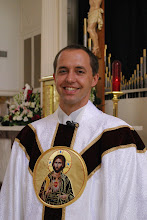
TRANSFIGURATION
(Matthew 17: 1-9) After six days Jesus took Peter, James, and John his brother, and led them up a high mountain by themselves. And he was transfigured before them; his face shone like the sun and his clothes became white as light. And behold, Moses and Elijah appeared to them, conversing with him. Then Peter said to Jesus in reply, "Lord, it is good that we are here. If you wish, I will make three tents here, one for you, one for Moses, and one for Elijah." While he was still speaking, behold, a bright cloud cast a shadow over them, then from the cloud came a voice that said, "This is my beloved Son, with whom I am well pleased; listen to him." When the disciples heard this, they fell prostrate and were very much afraid. But Jesus came and touched them, saying, "Rise, and do not be afraid." And when the disciples raised their eyes, they saw no one else but Jesus alone. As they were coming down from the mountain, Jesus charged them, "Do not tell the vision to anyone until the Son of Man has been raised from the dead."

Historical Background:
Mount Tabor is the mountain that abruptly rises from the Jezreel plain to a height of 1900 feet. It is SE of Nazareth. It is a landmark when one is in the plain of Jezreel or the plain of Armageddon as it is the only cone shaped mountain in the area. The mountain was considered Holy by the Northern Jewish tribes. Barak, by the order of Deborah, destroyed the army of Sisara. (Judith 4, 6). Altars were built for the heathen gods, for which Hosea upbraids the people. Antiochus III in 218 B.C. and Vespesian in 67 A.D. occupied this strategic place. Many say the transfiguration was at Banyas, which is a six days journey from Tabor. The events of the Bible do not lead credence to this. In the fourth century a basilica in honor of the Transfiguration was built here, and a sixth-century pilgrim reported three basilicas there, honoring Moses, Elijah, and Jesus. In the 9th century 4 churches and 18 monks with a bishop lived here. During the Latin domination, the mountain was given to the Benedictine monks but had to leave in 1187. The monastery and church was destroyed by the Muslims in 1212. In 1255, Clement IV gave the mountain to the Order of Hospital of St. John but was destroyed again by the Muslims in 1263. The shrine was abandoned for nearly 400 years. When it was safe, the Franciscans from Nazareth would climb the mountain on the feast of the Transfiguration. Francis of Verrazzano of Tuscany, obtained in 1631 the formal permission for the Franciscans to settle on the mountain from Emir Fakhredin. The ruins of the immense Crusader monastery of almost 1000 years ago surround the beautiful church.

Today's Basilica of the Transfiguration incorporates some of the ancient elements. On the right and left of the entrance are two older chapels, one dedicated to Elijah, the other to Moses. A mosaic of the transfiguration dominates the upper level of the church. The lower level contains remains of the Byzantine church and is marked by a window of a peacock, a traditional symbol of the resurrection. When the church was built about 50 years ago, the roof was of translucent alabaster, now covered over. The alabaster windows still give a sense of subdued glory. The image of the peacock in the window of the crypt (actually the ancient Byzantine Church) is symbolic of the Resurrection. The mosaic in the apse over the main altar is of the transfiguration. In the rear, incorporated into the present edifice are two ancient chapels to Moses and Elijah. Later Christians accomplished what the disciples could not: they have built three tabernacles here! The dazzling garments of Jesus and his glowing face are an expression of divinity, of the glory of God's Son (verse 2). Moses and Elijah, ancient figures representing God's revelation in the Old Testament, appear with Jesus (verse 3). Peter, filled with awe and reverence, wanted to keep this experience forever and suggested that he erect three tents for them (verse 4). The voice of God identifies Jesus as his Son and asks that his disciples "listen to him" (verse 5). In Eastern Christian spirituality, the transfiguration expresses the belief that God wants to transform us all into his own divine likeness. In the transfiguration we experience a person totally possessed by God, completely on fire with God, perfectly reflecting the divine image. This divinization is what our transforming God would do if he were truly given free rein in our lives. We have all had glimpses this experience: when we touch God personally in deep prayer, when our hearts are lifted listening to glorious music, when awe¬some worship fills our spirits with holiness. The account of the transfiguration occurs in the gospel immediately after Jesus first prophesies his death and begins his journey toward Jerusalem. This is a reminder to us that transforming experiences of God's presence are never given to us simply to be enjoyed for their own sake. The gift is given within the context of our vocation, to strengthen us for God's calling-a calling that, for the Christian, always includes the call to take up the cross.

This is beautiful and touching, almost as much as when we were really there a year ago! God's blessings to all our pilgrimage friends. Gracie
ReplyDelete